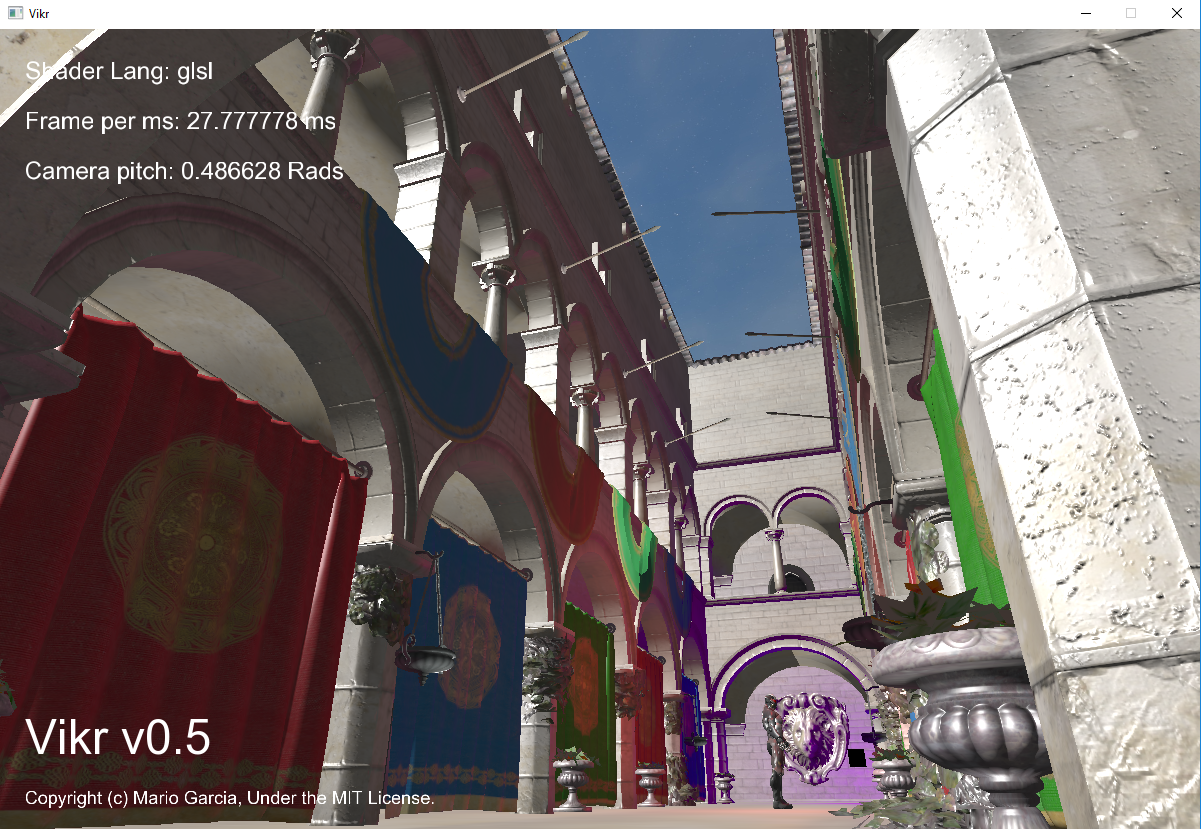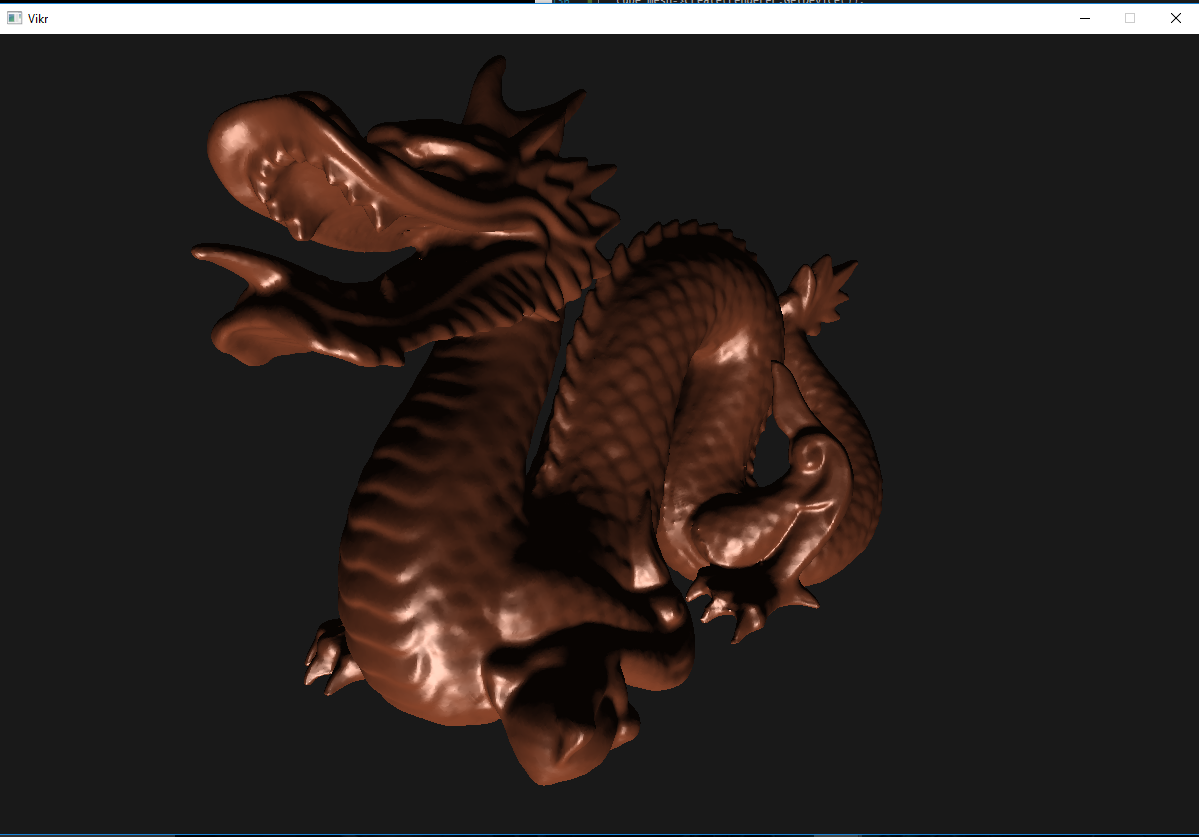Vikr is a smallscale renderer using OpenGL 4.3 and Vulkan API graphics. It is an academic graphics engine solely designed for researching computer graphics and testing shaders for academic use. Its capability does not stop in just mere research, as it can also be used for startup game engines and other possibilities involving physics and computer vision. It is still in current development, so use this engine for hobbyist use, and not for professional work!
Vikr Rendering implementation involves a large use of abstraction:
Currently all resources and implementations within the engine source code is subject to change, so keep in mind that this engine is not fully stable. I only ask for patience until the engine is fully implemented, cleaned up, and optimized. Contribution is always welcome!
The Design goal of this renderer is to allow the user to handle memory management, while the Engine merely uses the data given to manipulate the objects it must render. VERY STRONG emphasis in avoiding dynamic allocation as much as possible.
The image below describes the current, stable, implementation of the Vikr Renderer:
Keep in mind that the following image was rendered in OpenGL:

Current Features:
- Working Scene Graph with customizable components.
- Model Loader ready.
- Deferred Shading and lighting.
- OpenGL Ready.
- Blinn-Phong default shading
- Bumpmaps (Tangent and BiTangent spaces)
- Cubemaps (skyboxes as well).
- Graphics Layer hardware abstraction with plugin Render Devices (This allows easier plugins for OpenGL, Vulkan, etc...)
- GLSL Compiler, Preprocessor, and Linker ready.
- Quaternion-based Motion Camera.
- Cross compatibility with Windows and Linux.
Work in Progress:
- Vulkan implementation (for a more modern Graphics API)
- Shadow Mapping
- SSAO
- Parallax Mapping
- HDR and Bloom
Future Works:
- Physically Based Rendering (PBR)
- Animation
- Audio (For some sounds with your Scene?)
- Camera Frustum Culling
- Octree Culling
- Vikr Editor (for easier editing when using Vikr)
- Multithreaded Rendering
- Metal and DirectX 12 implementations
To build this project, you need the following:
- CMake (the latest version)
- a C++ Compiler (Visual Studio for Windows, GCC for Linux, Clang for OSX (not tested), or Intel, whichever really)
- Graphics Card with Vulkan Ready Driver (if you plan on using Vulkan).
When cloning, be sure to add in the submodules as well!
git clone https://github.com/Cheezboiger/Vikr.git
cd Vikr
git submodule update --init --recursive
This Project comes with a cmake script, ready to setup the project without too much hassle. The real hassle would be the shader files, which when compiling and running, the program would not know where to look (I still need to work on the filesystem handles for the Renderer). For now, simply copy/paste the shaders from the lib folder into the directory of where the executable was compiled and linked, and store them into a folder called "shaders" within the same directory as the executable. This will be fixed soon, I promise!
simply create a folder and use the cmake gui to build the project for you. If you are doing the command line (or terminal) way, just type, within your folder that you plan to build the project in:
cmake -Dvulkan=ON path/to/vikr/project/
This is an engine solely for researching and as a hobby, especially if you are interested in how Renderers work. If you are looking for a well designed Graphics Renderer, I suggest looking into Pixar's RenderMan, Autodesk Maya, 3DSMax, AutoCAD, Blender, and/or other professional software. If you are looking for a stable Game Engine for Game development, I would definitely recommend Unity, Unreal Engine (highly recommend), Crytek Engine, Cocos2D, Torque, BansheeEngine, Pomdog and/or other professional/indie game engines.
If you are interested in Graphics Programming, I would suggest you look into Joey De Vries LearnOpenGL tutorials and, if you are ready, into Alex Overvoorde's Vulkan Tutorials. This Graphics engine would not be possible without their tutorials.
Vulkan tutorials: https://vulkan-tutorial.com/ OpenGL tutorials: https://learnopengl.com/
Credits out to Joey De Vries and his tutorials on OpenGL, which has taught me, through simple to understand, steps on learning graphics programming! check out his tutorial website: http://learnopengl.com/#!Introduction
You should also check out his work in progress engine here as well, as he is implementing much more advanced work than me! : https://github.com/JoeyDeVries/Cell
Notable mention to Koray Hagen and his delectable knowledge on Computer Graphics rendering, helping me by pointing the way to certain rendering techniques with tangent space normal mapping and Skew-Symmetric Matrices.
